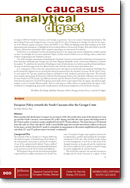Armenias European Choice After the 2012-13 Elections

Autor(en): Iris Kempe
Herausgeber: Jeronim Perovic, Lili Di Puppo, Iris Kempe, Heiko Pleines, Matthias Neumann, Robert Orttung
Serie: Caucasus Analytical Digest (CAD)
Ausgabe: 53
Seiten: 32-35
Verlag(e): Center for Security Studies (CSS), ETH Zurich; Research Centre for East European Studies, University of Bremen; Institute for European, Russian and Eurasian Studies, George Washington University
Publikationsjahr: 2013
